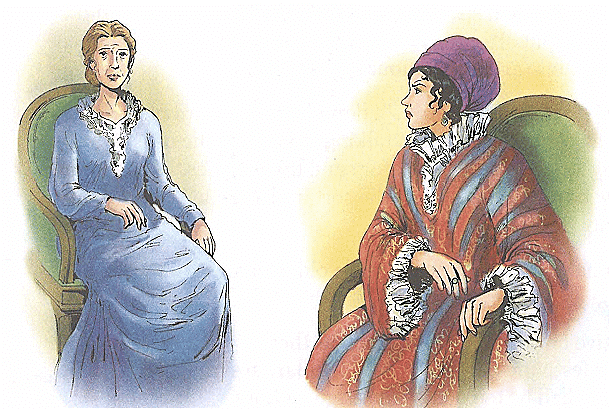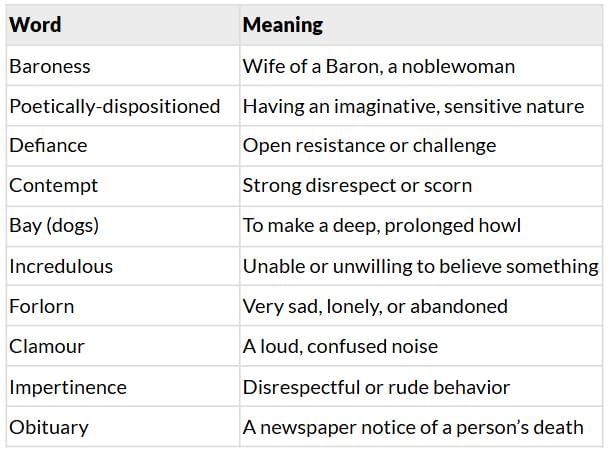The Wolves of Cernogratz Chapter Notes | Gul Mohar Class 7: Book Solutions, Summaries & Worksheets PDF Download
| Table of contents |

|
| About the Author |

|
| Detailed Summary |

|
| Moral / Message |

|
| Character Sketches |

|
| Vocabulary Table |

|
About the Author
Hector Hugh Munro (1870–1916), better known by his pen name Saki, was a British writer famous for his witty, sharp, and sometimes dark short stories. His works often criticize the hypocrisy and pretensions of upper-class society. His most famous stories include The Open Window and The Lumber Room.
Detailed Summary
The story is set in Castle Cernogratz, recently bought by the wealthy but unimaginative Baron and Baroness Gruebel. The family dismisses the legends of the castle, which claim that when a member of the original Cernogratz family dies there, wolves howl in the forest and a tree crashes in the park.
During dinner, their old governess, Amalie Schmidt, unexpectedly speaks up. Normally silent and overlooked, she reveals that the legend is true, but only for members of the von Cernogratz family. To everyone’s shock, she declares that she herself is a von Cernogratz, who had changed her name when her family became poor and she was forced to work as a governess. The Baron and Baroness angrily dismiss her claim, mocking her background.
Soon after, Amalie falls seriously ill. On a bitter winter night, while the family entertains guests, the castle dogs begin to bark wildly. From the forest comes the eerie, haunting howls of wolves. At the same time, a tree crashes in the park. The guests are terrified, but Amalie, lying on her deathbed, is filled with peace and pride. She asks for the window to remain open so she can hear the “death-music” of her family. She dies content, knowing the ancient legend has honored her as the last von Cernogratz in the castle.
The next day, the Baron and Baroness dismiss the events, insisting it was only the cold that caused the wolves to gather and the tree to split. In the newspaper obituary, Amalie is described merely as a “valued friend” of the Baroness—her noble family heritage ignored.
Moral / Message
The story highlights themes of pride, identity, and social class. The Baroness and her family value wealth and appearances, but Amalie proves that true dignity comes from heritage, memory, and inner strength. Saki also satirizes the arrogance of the nouveau riche (newly rich) who try to buy history but can never truly inherit it. The message: true nobility lies in character and legacy, not in wealth or titles.
Character Sketches
Amalie von Cernogratz (the governess)
A quiet, faded governess who reveals her noble lineage only at the end. Though ignored and mocked, she dies with dignity, proud of her heritage. She represents hidden strength, loyalty to memory, and the unbreakable bond with her family legacy.
Baroness Gruebel
A wealthy woman who buys Castle Cernogratz but has no respect for its traditions or legends. She is cold, arrogant, and materialistic, unable to understand Amalie’s pride.
Conrad (the merchant brother)
More sensitive than the rest of his family, he is poetically inclined. Unlike the Baroness, he shows empathy toward Amalie and is moved by her emotions and the mystery of the legend.
The Baron
Dismissive and mocking, he refuses to believe Amalie’s story and ridicules her claim. He represents materialism and insensitivity.
Vocabulary Table

|
28 videos|56 docs|17 tests
|
FAQs on The Wolves of Cernogratz Chapter Notes - Gul Mohar Class 7: Book Solutions, Summaries & Worksheets
| 1. What is the main theme of "The Wolves of Cernogratz"? |  |
| 2. Who are the key characters in "The Wolves of Cernogratz" and what are their roles? |  |
| 3. What moral lessons can be derived from "The Wolves of Cernogratz"? |  |
| 4. How does the setting influence the events in "The Wolves of Cernogratz"? |  |
| 5. What vocabulary is essential for understanding "The Wolves of Cernogratz"? |  |















